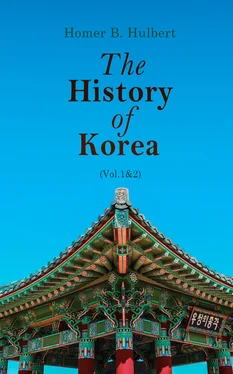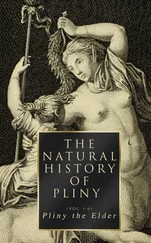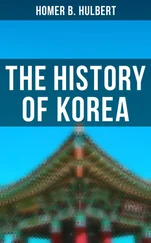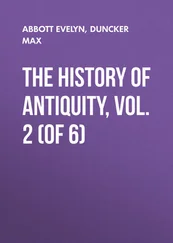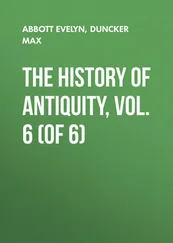As this kingdom included only six of the Chin-han states, it would be difficult to give its exact boundaries. From the very first it began to absorb the surrounding states, until at last it was bounded on the east and south by the sea alone, while it extended north to the vicinity of the Han River and westward to the borders of Na-han, or to Chi-ri San. It took her over four hundred years to complete these conquests, many of which were bloodless while others were effected at the point of the sword. It was not until the twenty-second generation that the name Sil-la was adopted as the name of this kingdom.
It is important to notice that the island of Tsushima, whether actually conquered by Sil-la or not, became a dependency of that Kingdom and on account of the sterility of the soil the people of that island were annually aided by the government. It was not until the year 500 A.D. or thereabouts that the Japanese took charge of the island and placed their magistrate there. From that time on, the island was not a dependency of any Korean state but the relations between them were very intimate, and there was a constant interchange of goods, in a half commercial and half political manner. There is nothing to show that the daimyos of Tsushima ever had any control over any portion of the adjacent coast of Korea.
It gives one a strong sense of the trustworthiness of the Korean records of these early days to note with what care the date of every eclipse was recorded. At the beginning of each reign the list of the dates of solar eclipses is given. For instance, in the reign of Hyŭk-kŭ-se they occurred, so the recordsthe records say, in the fourth, twenty-fourth, thirtieth, thirty-second, forty-third, forty-fifth, fifty-sixth and fifty-ninth years of his reign. According to the Gregorian calendar this would mean the years 53, 31, 27, 25, 14, 12 B.C. and 2. A.D. If these annals were later productions, intended to deceive posterity, they would scarcely contain lists of solar eclipses. The marvelous or incredible stories given in these records are given only as such and often the reader is warned not to put faith in them.
The year 48 B.C. gives us the first definite statement of a historical fact regarding Japanese relations with Korea. In that year the Japanese pirates stopped their incursions into Korea for the time being. From this it would seem that even at that early date the Japanese had become the vikings of the East and were carrying fire and sword wherever there was enough water to float their boats. It would also indicate thatthat the extreme south of Korea was not settled by Japanese, for it was here that the Japanese incursions took place.
In 37 B.C. the power of the little kingdomkingdom of Sil-la began to be felt in surrounding districts and the towns of Pyön-han joined her standards. It was probably a bloodless conquest, the people of Pyön-han coming voluntarily into Sil-la. In 37 B.C. the capital of Sil-la, which had received the secondary name Keum-sŭng, was surrounded by a wall thirty-five li , twelve miles, long. The city was 5,075 paces long and 3,018 paces wide. The progress made by Sil-la and the evident tendency toward centralisation of all power in a monarchy aroused the suspicion of the king of Ma-han who, we must remember, had considered Chin-han as in some sense a vassal of Ma-han. For this reason the king of Sil-la, in 19 B.C., sent an envoy to the court of Ma-han with rich presents in order to allay the fears of that monarch. The constant and heavy influx into Sil-la of the fugitive Chinese element also disturbed the mind of that same king, for he foresaw that if this went unchecked it might mean the supremacy of Sil-la instead of that of Ma-han. This envoy from Sil-la was Ho-gong, said to have been a native of Japan. He found the king of Ma-han in an unenviable frame of mind and it required all his tact to pacify him, and even then he succeeded so ill that had not the Ma-han officials interfered the king would have had his life. The following year the king of Ma-han died and a Sil-la embassy went to attend the obsequies. They were anxious to find opportunity to seize the helm of state in Ma-han and bring her into the port of Sil-la, but this they were strictly forbidden to do by their royal master who generously forebore to take revenge for the insult of the preceding year.
As this was the year, 37 B.C., whichwhich marks the founding of the powerful kingdom of Ko-gur-yŭ, we must turn our eyes northward and examine that important event.
As the founder of Ko-gur-yŭ originated in the kingdom of Pu-yŭPu-yŭ, it will be necessary for us to examine brieflybriefly the position and status of that tribe, whose name stands prominently forth in Korean history and tradition. There were four Pu-yŭs in all; North Pu-yŭ, East Pu-yŭ, Chŭl-bŭn Pu-yŭ and South Pu-yŭ. We have already, under the head of the Tan-gun, seen that tradition gives to Pu-ru his son, the honor of having having been the founder of North Pu-yŭ, or Puk Pu-yŭ as it is commonly called. This is quite apocryphal but gives us at least a precarious starting point. This Puk Pu-yŭ is said by some to have been far to the north in the vicinity of the Amur River or on one of its tributaries, a belief which is sustained to a certain extent by some inferences to be deduced from the following legend.
It must have been about fifty years before the beginning of our era that King Hă-bu-ru sat upon the throne of North Pu-yŭ. His great sorrow was that Providence had not given him a son. Riding one day in the forest he reached the bank of a swift rushing stream and there dismounting he besought the Great Spirit to grant him a son. Turning to remount he found the horse standing with bowed head before a great boulder while tears were rolling down its face. He turned the boulder over and found beneath it a child of the color of gold but with a form resembling a toad. Thus was his prayer answered.answered. He took the curious child home and gave it the name Keum-wa or “Golden Toad.” Soon after this the kingdom removed to East Pu-yŭ, or Tong Pu-yŭ, somewhere near the “White Head Mountain,” known as Păk-tu San.
Arriving at the age of manhood, Keum-wa looked about for a wife. As he was walking along the shore of U-bal-su (whether river or sea we do not know) he found a maiden crying. Her name was Yu-wha, “Willow Catkin.” To his inquiries she replied that she was daughter of the Sea King, Ha-băk, but that she had been driven from home because she had been enticed away and ravished by a spirit called Ha-mo-su. Keum-wa took her home as his wife but shut her in a room to which the sun-light had access only by a single minute aperture. Marvelous to relate a ray of light entered and followed her to whatever part of the room she went. By it she conceived and in due time gave birth to an egg, as large as five “measures.” Keum-wa in anger threw it to the pigs and dogs but they would not touch it. Cattle and horses breathed upon it to give it warmth. A stork from heaven settled down upon it and warmed it beneath her feathers. Keum-wa relented and allowed Yu-wha to bring it to the palace, where she wrapped it in silk and cotton. At last it burst and disclosed a fine boy. This precocious youth at seven years of age was so expert with the bow that he won the name of Chu-mong, “Skillful Archer.” He was not a favorite with the people and they tried to compass his death but the king protected him and made him keeper of the royal stables. Like Jacob of Holy Writ he brought his wits to bear upon the situation. By fattening the poorer horses and making the good ones lean he succeeded in reserving for his own use the fleetest steeds. Thus in the hunt he always led the rout and secured the lion’s share of the game. For this his seven brothers hated him and determined upon his death. By night his mother sought his bed-side and whispered the word of warning. Chu-mong arose and with three trusty councillors, O-i, Ma-ri and Hyŭp-pu, fled southward until he found his path blocked by the Eum-ho River. There was neither boat, bridge nor ford. Striking the surface of the water with his bow he called upon the spirit of the river to aid him, for behind him the plain smoked with the pursuing hoof-beats of his brothers’ horses. Instantly there came up from the depths of the river a shoal of fish and tortoises who lay their backs together and thus bridged the stream.
Читать дальше
